
The mottled umber is a moth of the family Geometridae. It is common throughout much of the Palearctic region. The species was first described by Carl Alexander Clerck in 1759.

Callistege mi, the Mother Shipton moth, is a moth of the family Erebidae. It was classified by Carl Alexander Clerck in 1759, and is also known under the name of Euclidia mi. In Finnish it is known as piirtoyökkönen and in German as Scheck-Tageule.

The raft spider, scientific name Dolomedes fimbriatus, is a large semi-aquatic spider of the family Pisauridae found throughout north-western and central Europe. It is one of only two species of the genus Dolomedes found in Europe, the other being the slightly larger Dolomedesplantarius which is endangered in the UK.

The yellow-legged buttonquail is a buttonquail, one of a small family of birds which resemble, but are unrelated to, the true quails. They are endemic to the Indian subcontinent, East Asia and Southeast Asia. There are two recognised subspecies; T. t. tanki is found in Pakistan, India and Nepal, and the Andaman and Nicobar Islands; and T. t. blanfordii is found in Myanmar, and Indochina, and eastwards to eastern China. It also migrates to and breeds in the Korea peninsular and the southernmost parts of southeast Russia.

Araniella cucurbitina, sometimes called the "cucumber green spider", is a spider of the family Araneidae.

Zygiella x-notata, sometimes known as the missing sector orb weaver or the silver-sided sector spider, is a spider species in the family Araneidae. They are solitary spiders, residing in daily-spun orb webs. Z. x-notata is a member of the genus Zygiella, the orb-weaving spiders. The adult female is easily recognized by the characteristic leaf-like mark on her posterior opisthosoma, caudal to the yellow-brown cephalothorax.

Ordgarius magnificus, the magnificent spider, is a bolas spider in the family Araneidae. It is endemic to forests along the Australian east coast.
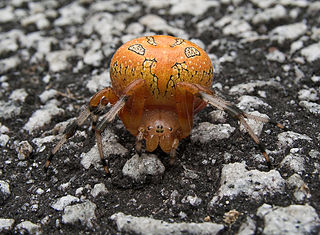
Araneus marmoreus, commonly called the marbled orb-weaver, is a species of spider belonging to the family Araneidae. It is sometimes also called the pumpkin spider from the resemblance of the female's inflated abdomen to an orange pumpkin. It has a Holarctic distribution.

Heteropoda davidbowie is a species of huntsman spider of the genus Heteropoda. It was described from the Cameron Highlands District in peninsular Malaysia and named in honour of singer David Bowie.

Eudocima phalonia, the common fruit-piercing moth, is a fruit piercing moth of the family Erebidae. The species was first described by Carl Linnaeus in his 1763 Centuria Insectorum. It is found in large parts of the tropics, mainly in Asia, Africa and Australia but introduced into other areas such as Hawaii, New Zealand and the Society Islands. It is one of major fruit pests in the world.

Dixeia pigea, the ant-heap small white or ant-heap white, is a butterfly in the family Pieridae that is native to Africa.
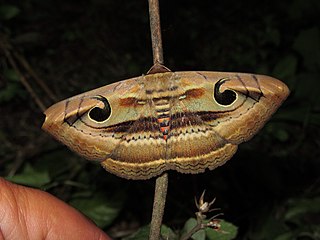
Spirama retorta, the Indian owlet-moth, is a moth of the family Erebidae. The species was first described by Carl Alexander Clerck in 1764. It is found in China, Korea, Japan (Honshu), India, Nepal, Bangladesh, Thailand, Cambodia, Myanmar, Vietnam, Taiwan, Sri Lanka, Malaysia, the Philippines (Luzon), Indonesia ,Japan.

Pardosa monticola, or pin-stripe wolf spider, is a species of wolf spider found mainly in Europe. It is found in both dry and humid habitats, and up to an altitude of 2000m.
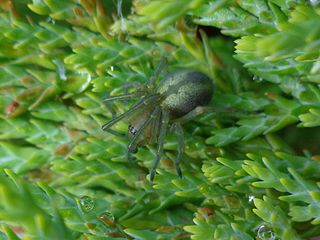
Cheiracanthium erraticum, the two-clawed hunting spider, is a species of Palearctic spider of the family Cheiracanthiidae.

Xysticus cristatus, the common crab spider, is a European spider from the family Thomisidae.
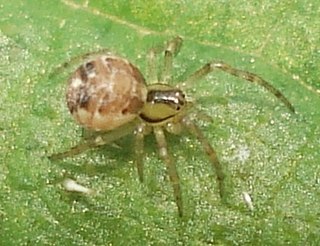
Phylloneta impressa is a species of comb-footed spider from the genus Phylloneta with a Holarctic distribution.

Philodromus aureolus, the wandering crab spider, is a mainly European running crab spider of the family Philodromidae. The taxonomy of the species group named after Philodromus aureolus is in a state of flux and a number of new species have recently been recognised.
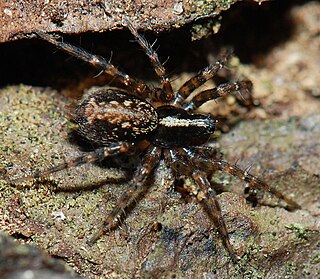
Textrix dendiculata, the toothed weaver, is a funnel web spider of the family Agelenidae found in much of Europe. It was described by the French entomologist Guillaume-Antoine Olivier in 1789. An older name coined by Martini & Goeze in 1778, Aranea cruciger, has been declared a nomen oblitum, allowing Olivier's later name to stand.

Tetragnatha montana, commonly known as the silver stretch spider, is a species of long-jawed orb weaver from the family Tetragnathidae that has a Palearctic distribution. It preys mostly on flies and mosquitoes. The name silver stretch spider refers to its shiny metallic colour and its habit of extending its legs into a stick like shape.

Avicularia juruensis is a species of spider in the family Theraphosidae, found in South America. Avicularia urticans was brought into synonymy in 2017. It has been given the English name Amazonian pink toe spider. Under the synonym Avicularia urticans, it is also known as the Peruvian pinktoe tarantula. It is a large mygalomorph spider, with a maximum body length over 30 mm (1.2 in) and the longest fully extended leg about 60 mm (2.4 in). Like other species in the genus Avicularia, specimens under this name are sold as pets, although their identity has not been confirmed by taxonomic studies.




















